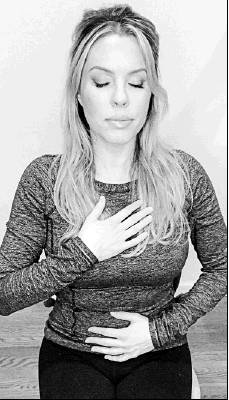IN THE GAME
Learn to recharge your mind with the art of meditation
By Ashley B. Greenblatt FOR THE INQUIRER
How mighty is your mind? Being “fit” is often thought of in purely physical terms, with big biceps and a tight tummy indicative of good health. But brain power is needed, as well.
The brain is a complex organ, yet in a lot of ways, it’s similar to the muscles we train at the gym. It requires repetitions to strengthen and sharpen core skills, as well as rest and recovery to heal.
When muscles tire and fatigue, we stretch. Your brain also needs to release stress and tension from overstimulation. It takes only 10 minutes a day to relieve and recharge your mind from its heavy workload. In this short period of time you can increase your clarity, productivity, reduce stress and improve your overall ability to function.
Try these simple steps to become a master meditator:
A peaceful place. We tend to value and prioritize others’ time over our own. When kids, work and friends take priority, our ability to manage stress suffers. This, coupled with such other external stressors as financial worries or marital troubles, can make your mind feel completely out of control. Unmanaged, these pressures can cause such conditions as anxiety and depression, and even lead to physical consequences such as heart attack and stroke.
We can’t help those we love unless we help ourselves first. This starts by finding a quiet place, without interruption, where you can unwind.
Breathe easy. Once you find your peaceful place, silence all devices and draw the blinds. Position your body comfortably on a seat, or lie on your back on the floor with your head propped on a pillow for support. Focus only on your breathing. Observing each inhale and exhale.
Most of us are shallow breathers, filling the chest with little pockets of air rather than fully expanding the ribs and belly. Shallow, rapid breathing contributes to worrisome symptoms such as dizziness, chest discomfort, heart palpitations, mental fog, and a choking sensation.
Place one hand on your stomach and one on your chest. This is an easy technique for gauging whether your stomach, rather than your chest, is swelling with each breath.
A sigh of relief. Your body absorbs mental stressors. Some will notice this in the form of tension headaches and temporomandibular joint dysfunction (TMJ), while others may experience stomach distress, chest pain, a stiff neck, or backaches.
Continue taking slow, steady, deep breaths. And while doing so, scan your body for the following tension hot spots:
Head. If your eyes are scrunched and squinted, release the muscles surrounding your eyes, forehead and nose. Open your jaw slightly to loosen clenched muscles near your mouth.
Shoulders. If your shoulders are pulled up toward your ears, relax and lower them.
Chest. If your shoulders are rounded forward, adjust your form by pushing your chest out and squeezing your shoulder blades together. This will allow for deep breaths.
Hands. When overwhelmed, we tend to unconsciously clench our hands. Ball your hands into tight fists. Notice the tension in your fingers and wrists. Now, slowly release your fingers and observe how nice it feels to relax these muscles.
Lower limbs. Your thighs and glutes should feel light, loose and limber.
Train of thought. Mastering meditation takes practice and patience. Don’t get frustrated if intrusive thoughts wander into your mind. A helpful visualization technique for letting go of such thoughts is to envision a river with a swift, soothing current. When a thought enters your mind, think of it like a leaf. Acknowledge and accept its presence, then watch it drift away. Refocus and return your attention to your body, your breathing, and the present moment.
Once your meditation is complete, try carrying this calm into the rest of your day. Meditation and mindfulness require daily reps to be effective. As with any form of exercise, it becomes easier and yields greater results with practice.
Ashley Blake Greenblatt is a certified personal trainer and wellness coach with a focus on movement and mindfulness.ashleyblakefitness.com
@ashleyblakefit ashley@ashleyblakefitness.com
